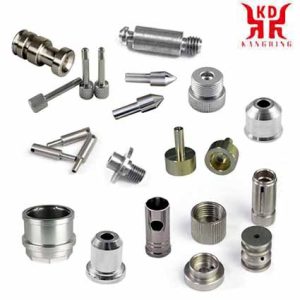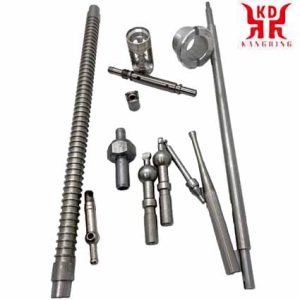Swiss CNC Machining and Turned Parts Manufacturer
Vários elementos-chave do torneamento de máquinas suíço incluem usinagem segmentada, características da peça, manutenção da bucha guia, ferramentas de corte, tamanho da máquina, e como evitar rebarbas. Tornos CNC de estilo suíço têm excelente precisão e flexibilidade de usinagem. Além de fornecer o desempenho de processamento e as vantagens de controle das máquinas-ferramentas CNC tradicionais, Tornos de estilo suíço também têm algumas características próprias. A aplicação eficiente de tornos de estilo suíço requer um método completamente diferente do processamento de torno comum.

Swiss machine precision turning

Usinagem CNC Suíça de Precisão
The development of Swiss-type CNC machine tool technology has helped to make these machine tools widely used in medical, aeroespacial, automotive, electronics and general metal processing. When the ratio of length to diameter of a complex workpiece will deviate during turning, the Swiss machine tool can be made effective by using a slidable headstock capable of feeding on the Z axis.
If you need to manufacture complex parts by a reliable precision CNC parts manufacturer, you can rely on Swiss CNC machining services in KANGDING. This is a top CNC machining company in China, specializing in CNC services and precision hardware production for decades. And has the ability to provide Swiss CNC machining services for the manufacturing needs of various industries around the world with the latest Swiss turning processing technology. With advanced Swiss lathes and Swiss machines, as well as other manufacturing facilities, our experienced experts and technicians can provide you with the most cost-effective solutions. The highest quality Swiss machine turned parts can be produced according to industry standards and customer requirements. From 5-axis milling services to Swiss CNC machining services, from Swiss CNC turning to wire cutting, no matter what type of CNC components you need, our team will help you get close to the standard. Processing materials include stainless steel, alumínio, cobre, and titanium, magnesium and so on. Welcome to contact us to get a free quote quickly.

Swiss machining workshop
Why choose Swiss machining services?
Custom CNC Swiss machine turning parts can be produced quickly and efficiently, suitable for high-volume production of small parts.
High speed and reliability will change quickly, and increase productivity will shorten the production cycle.
The width tolerance and high precision can be achieved for the complex parts project of precision Swiss CNC machining.
Due to the application of tools and sub-spindles, secondary processing is reduced, speeding up the entire process.
High-quality and high-end materials, careful operation, strict inspection of the entire processing process, and product quality testing.

Swiss machining of long and short shafts
Swiss CNC lathe service capabilities
Our CNC Swiss machining service is the choice of various industries. We have the ability to bring the best precision Swiss machined parts to your exact needs to meet the following materials.
Material: aço inoxidável (303, 304, 316, 416, 420, etc.), Aço carbono (1018, 1045, etc.), alumínio (6061, 6063, 7075, etc.), latão, cobre, plástico, etc..
Industries: medical instruments, surgical tools, optical measuring equipment, computer accessories, military and defense, watch industries, etc..
What is Swiss machine turning?
The Swiss lathe is a type of lathe in which the collet or holding mechanism is recessed behind the guide bushing. Swiss lathes are also known as Swiss turning centers, Swiss automatic lathes or Swiss screw machines. The difference between a Swiss lathe and a traditional lathe is that the collet holding the bar is not directly exposed under the mold and bed of the lathe. This type of configuration gives the machine tool certain advantages over traditional lathes.
Geralmente, Swiss machining refers to a precision manufacturing process, where components are produced on Swiss machines, and the parts rotate and move radially. Due to the unique design of Swiss machines, CNC Swiss turning services allow simultaneous execution of multiple operations in several areas in a short period of time. Portanto, the speed of machining is greatly improved. This type of machining technology is often used in small precision CNC rotating parts projects.
The advantage of Swiss lathes over traditional lathes is mainly due to the use of guide bushings. The purpose of the guide bushing is to provide additional support for the material while the part is being turned. The guide bushing tightly but not tightly surrounds the bar stock. The function of supporting the bar and the guide bushing is similar to that of being fixed on the carriage of a traditional lathe.
Swiss-style lathes usually have better tolerances on the parts because the turning operations are performed in the immediate vicinity of the guide bushing. The guide bushing provides rigidity to the turned part, because after leaving the bushing until the turning tool is engaged, only a few blanks are exposed. With the rigidity of the blanks imparted by the guide bushings, these machines are particularly suitable for maintaining tight tolerances. Another benefit of the Swiss lathe is that it can turn small diameter parts or parts with a large aspect ratio. Due to the juxtaposition of the tool/guide bushing, tool jitter can usually be minimized.
There are two types of Swiss lathe machines. Mechanical lathes use cams, gear systems and mechanical linkages to move the headstock and manipulate collets and tools. These types of machines have been replaced by computer numerical control (CNC) Swiss lathes in many places.
Swiss CNC lathes will utilize many computer-controlled components. During machine operation, many of these components can be adjusted. The advantage of the CNC Swiss lathe is that by adding a computer and its controlled components, the accuracy of the traditional machine tool can be maintained while improving the function of the machine tool.
Modern types of CNC Swiss lathes may include multi-spindle and powered auxiliary tools, moving tailstocks or auxiliary spindles. Depending on the required part configuration, some Swiss lathes have the ability to turn and machine complete parts. This eliminates the need for secondary operations.
The disadvantage of all Swiss lathes is bar residue. These are generally longer than traditional types of lathes and are generally considered waste products. The configuration of the chuck and guide bushing in the machine will cause a large amount of residue to remain.
What is a Swiss machine and how does a Swiss lathe work?
Swiss machine tools, also known as Swiss screw machines, Swiss lathes, Swiss automatic and sliding headstock lathes. It was developed in Switzerland in the 19th century, and its original function was to support the mass production of micro screws. Swiss-style machines can achieve higher precision and precision than traditional lathes, especially when producing very small parts. In traditional CNC lathes, they can only rotate in a fixed position, so the machine can only perform one operation at a time. On the Swiss lathe, the workpiece can both turn around and move back and forth along the z-axis, and it can perform multiple operations at the same time. The bar material is conveyed through the guide bushing, and the tool is installed on the surface of the guide bushing, so the force is exactly where the material emerges from the bushing, which will minimize the influence of the tool force on the part and then ensure higher accuracy. Além disso, Swiss turning machines can not only manufacture turned parts, but are also suitable for the production of complex profiles without turning surfaces.
 English
English العربية
العربية 中文(漢字)
中文(漢字) Čeština
Čeština Dansk
Dansk Nederlands
Nederlands Suomi
Suomi Français
Français Deutsch
Deutsch Italiano
Italiano 日本語
日本語 ಕನ್ನಡ
ಕನ್ನಡ 한국어
한국어 Português
Português Русский
Русский Slovenčina
Slovenčina Español
Español Svenska
Svenska Türkçe
Türkçe

